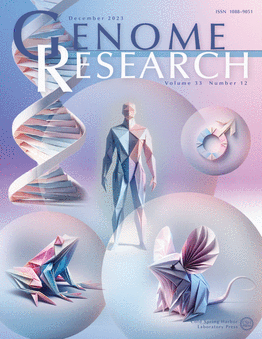Diverse evolutionary trajectories of mitocoding DNA in mammalian and avian nuclear genomes
IF 6.2
2区 生物学
Q1 BIOCHEMISTRY & MOLECULAR BIOLOGY
引用次数: 0
Abstract
Sporadically genetic material that originates from an organelle genome integrates into the nuclear genome. However it is unclear what processes maintain such integrations over evolutionary time. Recently it was shown that nuclear DNA of mitochondrial origin (NUMTs) may harbour genes with intact mitochondrial reading frames despite the fact that they are highly divergent from the host's mitochondrial genome. Two major hypotheses have been put forward to explain the existence of such mitocoding nuclear genes: (i) recent introgression from another species and (ii) long-term selection. To investigate whether these intriguing possibilities play a role we scanned the genomes of more than 1,000 avian and mammalian species for NUMTs. We show that the subclass of divergent NUMTs harbouring mitogenes with intact reading frames are widespread across mammals and birds. We show that some of these NUMTs appear to have similarity across species. We also demonstrate that many mitochondrial-coding NUMTs exhibit signs of long-term selection. In a subset of these NUMT genes, we detected evolutionary signals consistent with adaptive evolution, including one human NUMT shared among seven ape species. These findings suggest that NUMT insertions may occasionally be functional.哺乳动物和鸟类核基因组中有丝分裂编码DNA的不同进化轨迹
来自细胞器基因组的遗传物质偶尔会整合到核基因组中。然而,在进化过程中是什么过程维持了这种整合还不清楚。最近有研究表明,核DNA的线粒体起源(numt)可能包含完整的线粒体阅读框基因,尽管它们与宿主的线粒体基因组高度不同。有两个主要的假设被提出来解释这种核编码基因的存在:(i)最近从另一个物种的渗入和(ii)长期选择。为了研究这些有趣的可能性是否起作用,我们扫描了1000多种鸟类和哺乳动物物种的numt基因组。我们表明,具有完整阅读框的有丝分裂基因的发散型numt亚类广泛存在于哺乳动物和鸟类中。我们发现这些numt中的一些似乎在物种之间具有相似性。我们还证明了许多线粒体编码numt表现出长期选择的迹象。在这些NUMT基因的一个子集中,我们检测到与适应性进化一致的进化信号,包括七种猿类共有的一种人类NUMT。这些发现表明,NUMT插入偶尔可能是功能性的。
本文章由计算机程序翻译,如有差异,请以英文原文为准。
求助全文
约1分钟内获得全文
求助全文
来源期刊

Genome research
生物-生化与分子生物学
CiteScore
12.40
自引率
1.40%
发文量
140
审稿时长
6 months
期刊介绍:
Launched in 1995, Genome Research is an international, continuously published, peer-reviewed journal that focuses on research that provides novel insights into the genome biology of all organisms, including advances in genomic medicine.
Among the topics considered by the journal are genome structure and function, comparative genomics, molecular evolution, genome-scale quantitative and population genetics, proteomics, epigenomics, and systems biology. The journal also features exciting gene discoveries and reports of cutting-edge computational biology and high-throughput methodologies.
New data in these areas are published as research papers, or methods and resource reports that provide novel information on technologies or tools that will be of interest to a broad readership. Complete data sets are presented electronically on the journal''s web site where appropriate. The journal also provides Reviews, Perspectives, and Insight/Outlook articles, which present commentary on the latest advances published both here and elsewhere, placing such progress in its broader biological context.
 求助内容:
求助内容: 应助结果提醒方式:
应助结果提醒方式:


